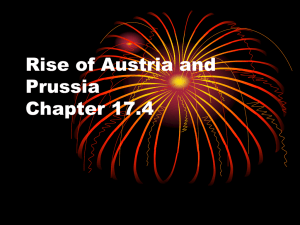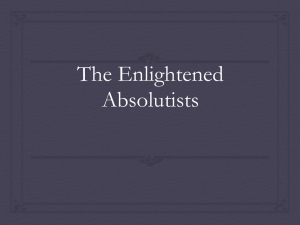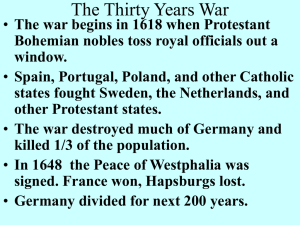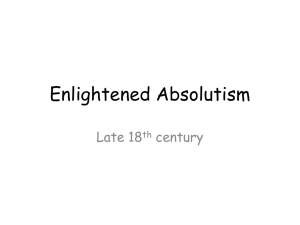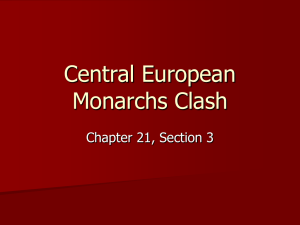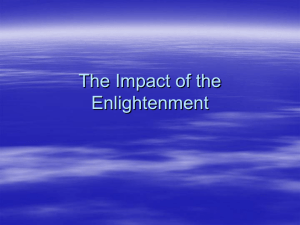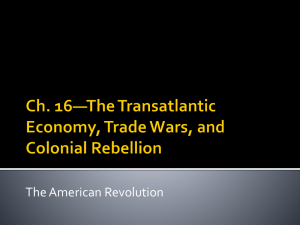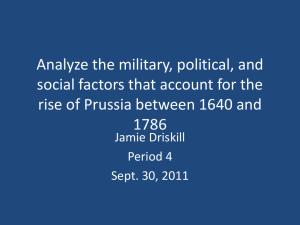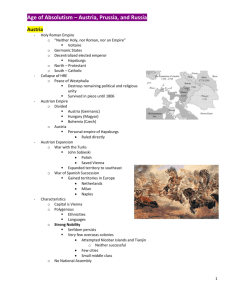Rise of Austria and Prussia
advertisement
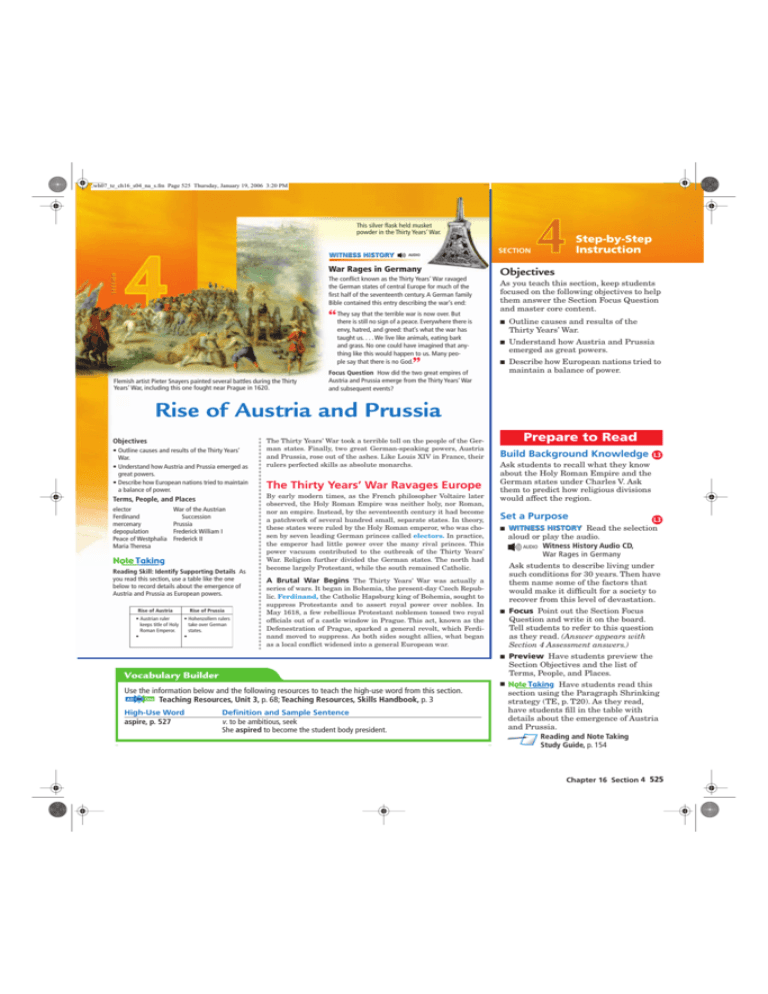
wh07_te_ch16_s04_na_s.fm Page 525 Thursday, January wh07_se_ch16_s04_s.fm Page 525 Thursday, November 17, 2005 10:44 19, AM 2006 3:20 PM This silver flask held musket powder in the Thirty Years’ War. WITNESS HISTORY AUDIO War Rages in Germany The conflict known as the Thirty Years’ War ravaged the German states of central Europe for much of the first half of the seventeenth century. A German family Bible contained this entry describing the war’s end: say that the terrible war is now over. But “ They there is still no sign of a peace. Everywhere there is envy, hatred, and greed: that’s what the war has taught us. . . . We live like animals, eating bark and grass. No one could have imagined that anything like this would happen to us. Many people say that there is no God. ” Flemish artist Pieter Snayers painted several battles during the Thirty Years’ War, including this one fought near Prague in 1620. SECTION 4 Step-by-Step Instruction Objectives As you teach this section, keep students focused on the following objectives to help them answer the Section Focus Question and master core content. ■ Outline causes and results of the Thirty Years’ War. ■ Understand how Austria and Prussia emerged as great powers. ■ Describe how European nations tried to maintain a balance of power. Focus Question How did the two great empires of Austria and Prussia emerge from the Thirty Years’ War and subsequent events? Rise of Austria and Prussia Objectives • Outline causes and results of the Thirty Years’ War. • Understand how Austria and Prussia emerged as great powers. • Describe how European nations tried to maintain a balance of power. Terms, People, and Places elector Ferdinand mercenary depopulation Peace of Westphalia Maria Theresa War of the Austrian Succession Prussia Frederick William I Frederick II Reading Skill: Identify Supporting Details As you read this section, use a table like the one below to record details about the emergence of Austria and Prussia as European powers. Rise of Austria Rise of Prussia • Austrian ruler • Hohenzollern rulers keeps title of Holy take over German Roman Emperor. states. • • The Thirty Years’ War took a terrible toll on the people of the German states. Finally, two great German-speaking powers, Austria and Prussia, rose out of the ashes. Like Louis XIV in France, their rulers perfected skills as absolute monarchs. The Thirty Years’ War Ravages Europe By early modern times, as the French philosopher Voltaire later observed, the Holy Roman Empire was neither holy, nor Roman, nor an empire. Instead, by the seventeenth century it had become a patchwork of several hundred small, separate states. In theory, these states were ruled by the Holy Roman emperor, who was chosen by seven leading German princes called electors. In practice, the emperor had little power over the many rival princes. This power vacuum contributed to the outbreak of the Thirty Years’ War. Religion further divided the German states. The north had become largely Protestant, while the south remained Catholic. A Brutal War Begins The Thirty Years’ War was actually a series of wars. It began in Bohemia, the present-day Czech Republic. Ferdinand, the Catholic Hapsburg king of Bohemia, sought to suppress Protestants and to assert royal power over nobles. In May 1618, a few rebellious Protestant noblemen tossed two royal officials out of a castle window in Prague. This act, known as the Defenestration of Prague, sparked a general revolt, which Ferdinand moved to suppress. As both sides sought allies, what began as a local conflict widened into a general European war. Prepare to Read Build Background Knowledge Set a Purpose ■ High-Use Word aspire, p. 527 Definition and Sample Sentence v. to be ambitious, seek She aspired to become the student body president. L3 WITNESS HISTORY Read the selection aloud or play the audio. AUDIO Witness History Audio CD, War Rages in Germany Ask students to describe living under such conditions for 30 years. Then have them name some of the factors that would make it difficult for a society to recover from this level of devastation. ■ Focus Point out the Section Focus Question and write it on the board. Tell students to refer to this question as they read. (Answer appears with Section 4 Assessment answers.) ■ Preview Have students preview the Section Objectives and the list of Terms, People, and Places. ■ Have students read this section using the Paragraph Shrinking strategy (TE, p. T20). As they read, have students fill in the table with details about the emergence of Austria and Prussia. Reading and Note Taking Study Guide, p. 154 Vocabulary Builder Use the information below and the following resources to teach the high-use word from this section. Teaching Resources, Unit 3, p. 68; Teaching Resources, Skills Handbook, p. 3 L3 Ask students to recall what they know about the Holy Roman Empire and the German states under Charles V. Ask them to predict how religious divisions would affect the region. Chapter 16 Section 4 525 wh07_te_ch16_s04_na_s.fm Page 526 Wednesday, November 9, 2005 12:54 PM wh07_se_ch16_s04_s.fm Page 526 Friday, September 30, 2005 4:19 PM L3 IRELA Have students read the Vocabulary Builder term and definition. Ask what Catholic rulers aspired to do in Europe. (to eradicate Protestantism) London Conic Projection 200 0 200 400 mi 40° N POLA Silesia Prague Bohemia Vienna AU S T R I A SWISS FED. Corsica Madrid T RA NS YL VA N IA Bla O TT EM OM AN PI RE Naples Sicily W E S European Nation-States, 1700 10° W 0° 20° E SWEDEN N W Stockho ic Nor th Sea Ba Berlin 50° N P R U I A S S w Warsa POLA ne Rhi R FRANCE Vienna 40° N A Bla ALPS Danube 400 km PY REN EES MT IA a tul Vis AU S T R I 400 mi SS ND R Conic Projection 200 Prague . Paris RU R. London Atla nt Ocea ic n 200 w sco . er R ND lt Dniep ENGLA 0 Mo Sea S Circulate to make sure students are filling in their Outline Maps accurately. lm 10° E E 0 ea ck S Map Skills After the pleThirty Years’ War, tino stan the Peace of Westphalia redrew the map Con of Europe. 1. Locate (a) Poland (b) Sweden (c) Spanish Netherlands (d) Westphalia 2. Regions (a) Who controlled BoheCrete mia in 1648? (b) What lands did the Spanish Hapsburgs control? 3. Drawing Conclusions How can you tell from the maps that the Holy Roman Empire was not a strong, unified state? Rome Mediterranean Sea 60° N Controlled by Spanish Hapsburgs Controlled by Austrian Hapsburgs Italian city-states Prussia Boundary of Holy Roman Empire ND Sardinia N Teaching Resources, Unit 3, p. 75 Monitor Progress R P Milan S PA I N A I A S S U BAVARIA FRANCE SSI l Papal State s Web Code nap-1641 to take the Geography Interactive Audio Guided Tour and then answer the map skills questions in the text. Have students fill in the Outline Map Europe After the Peace of Westphalia. Alsace 400 km n Quick Activity Have students access Independent Practice Paris Lorraine 0 Ba DENMARK Berlin Dutch N et h. I L WESTPHA A Spanish SAXONY N et h. AL 98: The Holy Roman Empire, About 1618. Ask students why the empire was difficult to rule and vulnerable to war. Point out that it really looked like a patchwork quilt. Then ask What happened in the Defenestration of Prague? (Protestant nobles tossed royal officials out the window.) Why did the war spread through Europe? (The continent was divided by religion and shifting political alliances.) What were the results of the war in German states? (One third of the population died; German lands were divided into 360 mostly small, independent states.) Color Transparencies, 98 ENGLAND Atla nt Ocea ic n POR T UG n Teach Display Color Transparency ND 50° N RU ti Nor th Sea SWEDEN cS ea 10° E SCOTLA ND Instruct n Introduce: Vocabulary Builder 20° E N O R W AY NG ARY 0° 10° W HU Teach The Thirty Years’ War Ravages Europe For: Audio guided tour Web Code: nap-1641 Europe After the Thirty Years’ War (1648) S. Madrid . ea ck S Major European monarchy Rome S PA I N Mediterranean Sea Answers Solutions for All Learners Map Skills L1 Special Needs 1. Review locations with students. 2. (a) Austrian Hapsburgs (b) Spain, Balearic Islands, Milan, Sardinia, Sicily, southern Italy, Spanish Netherlands, lands in the Holy Roman Empire 3. The map shows that areas within the Holy Roman Empire were ruled by several different powers, including Prussia and Spain. Help students use word roots and associations to learn definitions. Elector, like elect, comes from the Latin word electus, “chosen.” Defenestration comes from the Latin fenestra, or “window.” Depopulation comes from the Latin populus, “people,” as does the word popular. Have students write a definition of each word using a root or related word. 526 The Age of Absolutism L2 Less Proficient Readers L2 English Language Learners Use the following resources to help students acquire basic skills: Adapted Reading and Note Taking Study Guide n Adapted Note Taking Study Guide, p. 154 n Adapted Section Summary, p. 155 wh07_te_ch16_s04_na_s.fm Page 527 September Monday,28,November wh07_se_ch16_s04_s.fm Page 527 Wednesday, 2005 11:35 14, AM 2005 2:00 PM The following year, Ferdinand was elected Holy Roman Emperor. With the support of Spain, Poland, and other Catholic states, he tried to roll back the Reformation by force. In the early stages of the war, he defeated the Bohemians (who had rebelled when he became emperor) and their Protestant allies. Alarmed, Protestant powers like the Netherlands and Sweden sent troops into Germany. Before long, political motives outweighed religious issues. Catholic and Protestant rulers shifted alliances to suit their own interests. At one point, Catholic France joined Lutheran Sweden against the Catholic Hapsburgs. Instruct ■ A Terrible Loss of Life The fighting took a terrible toll. Roving armies of mercenaries, or soldiers for hire, burned villages, destroyed crops, and killed without mercy. Murder and torture were followed by famine and disease. Wolves, not seen in settled areas since the Middle Ages, stalked the deserted streets of once-bustling villages. The war led to a severe depopulation, or reduction in population. Exact statistics do not exist, but historians estimate that as many as one third of the people in the German states may have died as a result of the war. Introduce Have students locate the territory controlled by Hapsburg Austria on the map on the previous page. Have them compare it with the map of Europe in the back of the book and name modern countries that were once part of Hapsburg Austria. ■ Teach Use the Numbered Heads strategy (TE, p. T23) and ask What challenges did the Hapsburgs have in governing? (diverse peoples, languages, and cultures) Why was there doubt about the Austrian Succession? (The only heir was a young woman.) How did Maria Theresa rally support? (with a powerful speech to the Hungarian assembly) What were Maria Theresa’s successes? (strengthening and centralizing power, easing the burden of peasants) ■ Quick Activity Have students study and analyze the portrait of Maria Theresa on the next page. Then have them write and read aloud a brief speech from Maria Theresa to the Hungarian assembly, asking them to defend her empire. Take a vote on the best speech. Peace at Last Finally, in 1648, the exhausted combatants accepted a series of treaties, known as the Peace of Westphalia. Because so many powers had been involved in the conflict, the treaties aspired both to bring about a general European peace and to settle other international problems. Among the combatants France emerged a clear winner, gaining territory on both its Spanish and German frontiers. The Hapsburgs were not so fortunate. They had to accept the almost total independence of all the princes of the Holy Roman Empire. In addition, the Netherlands and the Swiss Federation (present-day Switzerland) won recognition as independent states. The Thirty Years’ War left German lands divided into more than 360 separate states—“one for every day of the year.” These states still acknowledged the rule of the Holy Roman emperor. Yet each state had its own government, currency, church, armed forces, and foreign policy. The German states, potentially the most powerful nation in Europe if they could be unified, thus remained fragmented for another 223 years. Hapsburg Austria Changes its Focus Vocabulary Builder aspired—(uh SPY urd) v. aimed; sought What were some effects of the Peace of Westphalia? Hapsburg Austria Changes its Focus Though weakened by war, the Hapsburgs still wanted to create a strong united state. They kept the title “Holy Roman emperor,” but focused their attention on expanding their own lands. To Austria, they would soon add Bohemia, Hungary, and, later, parts of Poland and some Italian states. Challenges to Unity Uniting these lands proved difficult. Not only were they divided by geography, they included a number of diverse peoples and cultures as well. By the 1700s, the Hapsburg Empire included Germans, Magyars, Slavs, and others. In many parts of the empire, people had their own languages, laws, political assemblies, and customs. The Hapsburgs did exert some control over these diverse peoples. They sent German-speaking officials to Bohemia and Hungary and settled Austrians on lands they had seized in these provinces. They also put down revolts in Bohemia and Hungary. Still, the Hapsburgs never developed a centralized governmental system like that of France. L3 Independent Practice Viewpoints To help students better understand the reign of Maria Theresa, have them read the selection Empress Maria Theresa and complete the worksheet. Teaching Resources, Unit 3, p. 74 Monitor Progress As students fill in their tables, circulate to make sure they understand how Austria emerged as a major power. For a completed version of the table, see Note Taking Transparencies, 118 Solutions for All Learners L4 Gifted and Talented L4 Advanced Readers Rivals Maria Theresa of Austria and Frederick II of Prussia both emerged from unpromising beginnings to become great and powerful rulers. Both loved the arts. Both came to power in 1740; she was 24, and he was 28. One of his first acts was to invade the Hapsburg province of Silesia, which Maria Theresa called “the rape of Silesia.” Frederick defended his action by saying “the passions of rulers have no other curb but the limits of their power.” To his surprise, Maria Theresa vigorously defended her domain, although she never regained Silesia. In grudging respect, Frederick began to refer to her as “that man in Vienna.” Have students research these two rivals and write a report comparing their lives and their reigns. Answer France gained land, the Hapsburgs lost land, the Netherlands and Swiss Federation gained independence, and the German lands were even more divided. Chapter 16 Section 4 527 wh07_te_ch16_s04_na_s.fm Page 528 Monday, November 14, 2005 2:01 PM wh07_se_ch16_s04_s.fm Hohenzollern Prussia/ The Rivalry of Great Powers Page 528 Friday, September 30, 2005 3:02 PM BIOGRAPHY L3 Instruct ■ Introduce Read aloud the words of Frederick William that “nothing else in the world can confer upon a prince such fame and honor as the sword.” Discuss with students whether this was true during this period and whether other absolute rulers would agree. ■ Teach Explain that as Prussia emerged as a strong power, the concept of a balance of power among European nations took on greater urgency. Ask How did the Hohenzollern consolidate power? (by seizing lands between their scattered holdings and setting up a central bureaucracy) What were the five main European powers? (Austria, Prussia, France, Britain, Russia) Then have students look at the map titled European Nation-States, 1700, two pages back. Ask them to predict where war would break out next in Europe and explain their reasoning. ■ Analyzing the Visuals Have students analyze the picture of young Frederick on the next page. Ask students to contrast this image of Frederick with the description in the text of Frederick’s military prowess. Independent Practice Read aloud the quote that “Prussia is not a state which possesses an army, but an army which possesses a state.” Tell students that Frederick William once savagely beat a soldier for having a button missing. Then have them write a short essay comparing Prussia and Sparta. Maria Theresa When Maria Theresa (1717–1780) became Hapsburg empress at the age of 23, her chances of remaining in power seemed very slim. She later said, “I found myself all at once without money, without troops, and without advice.” A decade after her crowning she wrote, “I do not think anyone would deny that history hardly knows of a crowned head who started his rule under circumstances more grievous than those attending my accession.” But the determined empress survived. She appointed superb advisors and was able to maintain control of her empire. During her 40year reign, Vienna became a center for music and the arts. Maria Theresa had one thing in common with most women of her day—being a mother. She gave birth to a total of 16 children—11 girls and 5 boys. Among them were future emperors Joseph II and Leopold II and Queen Marie Antoinette of France. What traits did Maria Theresa need to stay in power? A Woman Emperor Takes the Throne In the early 1700s, a new challenge threatened Hapsburg Austria. Emperor Charles VI had no male heir. His daughter, Maria Theresa, was intelligent and capable, but no woman had yet ruled Hapsburg lands in her own name. Charles persuaded other European rulers to recognize his daughter’s right to succeed him. When he died, however, many ignored their pledge. The War of the Austrian Succession Shortly after Charles’s death in 1740, Frederick II of Prussia seized the rich Hapsburg province of Silesia. This action sparked the eight-year War of the Austrian Succession. Maria Theresa set off for Hungary to appeal for military help from her Hungarian subjects. The Hungarians were ordinarily unfriendly to the Hapsburgs. But she made a dramatic plea before an assembly of Hungarian nobles. According to one account, the nobles rose to their feet and shouted, “Our lives and blood for your Majesty!” She eventually got further help from Britain and Russia, who did not want Prussia to upset the balance of power by gaining new lands. Maria Theresa never succeeded in forcing Frederick out of Silesia. Still, she did preserve her empire and win the support of most of her people. Equally important, she strengthened Hapsburg power by reorganizing the bureaucracy and improving tax collection. She even forced nobles and clergy to pay taxes and tried to ease the burden of taxes and labor services on peasants. As you will read, her son and successor, Joseph II, later extended many of her reforms. What caused the War of the Austrian Succession? Hohenzollern Prussia While Austria was molding a strong Catholic state, a region called Prussia emerged as a new Protestant power. In the 1600s, the Hohenzollern (HOH un tsahl urn) family ruled scattered lands across north Germany. In the century following the Peace of Westphalia, ambitious Hohenzollern rulers united their holdings, creating Prussia. Creating a Bureaucracy Hohenzollerns rulers set up an efficient central bureaucracy. Frederick William I was a Prussian ruler who came to power upon the death of his father in 1713. He cleverly gained the loyalty of the Prussian nobles, called Junkers (YOON kerz), by giving them positions in the army and government. His tactic reduced the nobles’ independence and increased his own control. Frederick also placed great emphasis on military values and forged one of the best-trained armies in Europe. One Prussian military leader boasted, “Prussia is not a state which possesses an army, but an army which possesses a state.” By 1740, Prussia was strong enough to challenge its rival Austria. A Crown Prince Learns the Art of War Frederick William made sure that, from an early age, his son Frederick was trained in the art of war. He wrote, Monitor Progress Primary Source tutor must take the greatest pains to imbue my son with a sincere love for “ His the soldier’s profession and to impress upon him that nothing else in the world can confer upon a prince such fame and honor as the sword. ” Check Reading and Note Taking Study Guide entries for student understanding. History Background Answers Maria Theresa’s succession to the throne and Frederick II’s invasion of Silesia. P R I M A RY S O U R C E Sample: determination, leadership, ability to judge character and to delegate, and good communication skills 528 The Age of Absolutism Frederick William King Frederick William of Prussia led a militaristic lifestyle that was impassioned, and at times, bizarre. In public, he always wore his military uniform. Like a good soldier, he regularly began his work day at five or six in the morning. At 10, he usually reported to the parade ground to drill or inspect the troops. Any lapse in military discipline might trigger his violent temper. Frederick William had an unusual admiration for tall soldiers, whom he regarded as possesing superior strength and stamina. Like a fanatical basketball coach seeking the championship, he sent scouts throughout much of Europe. Their mission was to entice, buy, and even kidnap the tallest soldiers for service in the Prussian army. wh07_te_ch16_s04_na_s.fm Page 529 Thursday, 19, wh07_se_ch16_s04_s.fm Page 529 Thursday, December 15, 2005January 11:47 AM 2006 3:21 PM In fact, young Frederick II preferred playing the flute and writing poetry. His father despised these pursuits and treated the young prince so badly that he tried to flee the country. Discovering these plans, Frederick William put his son in solitary confinement. Then he forced the 18-year-old prince to watch as the friend who had helped him was beheaded. Frederick’s harsh military training had an effect. After becoming king in 1740, Frederick II lost no time in using his army. As you have read, he boldly seized Silesia from Austria, sparking the War of the Austrian Succession. In several later wars, Frederick continued to brilliantly use his disciplined army, forcing all to recognize Prussia as a great power. His exploits earned him the name Frederick the Great. Assess and Reteach Assess Progress By 1750, the great European powers included Austria, Prussia, France, Britain, and Russia. These nations formed various alliances to maintain the balance of power. Though nations sometimes switched partners, two basic rivalries persisted. Prussia battled Austria for control of the German states, while Britain and France competed to develop their overseas empires. On occasion, these rivalries resulted in worldwide conflict. The Seven Years’ War, which lasted from 1756 until 1763, was fought on four continents. Prussia, Austria, Russia, France, and Britain battled in Europe. Britain and France also fought in India and Africa. In North America, where the conflict is known as the French and Indian War, Native American groups took sides with the French or the British. The Treaty of Paris ending these wars gave Britain a huge empire, thus changing Europe’s balance of power for the next hundred years. Petitioning a King Frederick the Great, strolling in his gardens, receives a petition from a common person. What characteristics of Frederick does the artist hint at in the painting? To further assess student understanding, use Progress Monitoring Transparencies, 70 L1 L2 Progress Monitoring Online Comprehension and Critical Thinking 3. Recognize Cause and Effect What impact did the Thirty Years’ War have on the German states? 4. Compare What two major powers emerged in Europe at the end of the Thirty Years’ War? How were the goals of these two nations similar? 5. Make Generalizations How did European nations maintain a balance of power? Spanish Reading and Note Taking Study Guide, p. 71 Extend L2 L4 The European Union (EU) today is a loose confederation of many independent states. Have students research the EU and write an essay comparing it with the Holy Roman Empire and predicting whether or not the EU is likely to be more successful and why. For: Self-quiz with vocabulary practice Web Code: naa-1641 1. Sentences should reflect an understanding of each term, person, or place listed at the beginning of the section. 2. After war decimated the Holy Roman Empire, strong rulers Maria Theresa, Frederick William, and Frederick II consolidated power and territory to build their empires. ■ Adapted Reading and L1 L2 Note Taking Study Guide, p. 71 What were the two main rivalries after 1750? Section 4 Assessment Administer the Section Quiz. If students need more instruction, have them read the section summary. Reading and Note Taking L3 Study Guide, p. 71 The Rivalry of Great Powers 2. Reading Skill: Identify Supporting Details Use your completed table to answer the Focus Question: How did the two great empires of Austria and Prussia emerge from the Thirty Years’ War and subsequent events? ■ Reteach his power? Terms, People, and Places 1. For each term, person, or place listed at the beginning of the section, write a sentence explaining its significance. Have students complete the Section Assessment. Teaching Resources, Unit 3, p. 66 How did Frederick William increase 4 L3 ■ ● Writing About History Quick Write: Write a Thesis Statement Select a topic from the section that you might use as the subject of a persuasive essay—for example, whether Austria or Prussia was more successful at developing a strong nation-state. Then write a thesis statement that summarizes your opinion on this topic. 3. The war depopulated the German states and weakened their unity, resulting in the emergence of many small independent states. 4. Austria and Prussia; both sought to consolidate power, build a strong state, and extend their territory. 5. European nations maintained a balance of power through wars and shifting alliances. Answers He controlled the Junkers, created an efficient bureaucracy, and established a strong army. England and France; Austria and Prussia Caption Sample: compassion, fair-mindedness, cultural literacy ● Writing About History Thesis statements should be appropriate for development in a persuasive essay and express a clear opinion. For additional assessment, have students access Progress Monitoring Online at Web Code naa-1641. Chapter 16 Section 4 529
